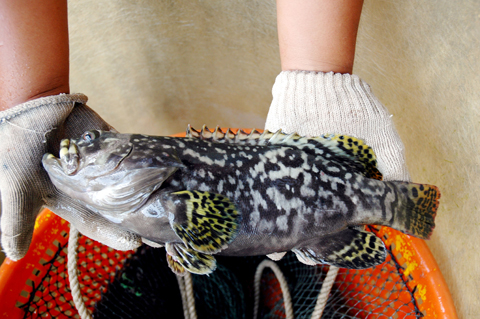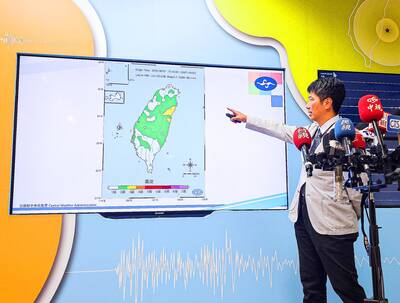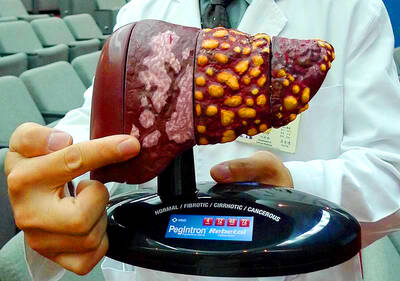With shrimp and eel farming becoming less competitive, the nation’s aquaculture industry is turning toward grouper, and the Council of Agricultural Affairs launched a program this year to increase the value of grouper farming by NT$10 billion (US$306 million) in four years. But Typhoon Morakot changed everything.
Now the grouper industry has to be rebuilt before it can become a key component of Taiwan’s aquaculture sector.
Linbian (林邊) and Jiadong (佳冬) townships, along with other areas in hard-hit Pingtung County are the main regional production centers for grouper. Their annual production — prior to Morakot — was 11,000 tonnes per year, or 65 percent of the nation’s 17,000 tonnes per year.

PHOTO: YEH YUNG-CHIEN, TAIPEI TIMES
Estimates from the industry, however, indicate that another three years will be needed before pre-Morakot levels are restored. The typhoon caused more than NT$4.1 billion in losses for the aquaculture industry — a record.
Grouper aquaculture alone sustained NT$2 billion in losses.
“If the damages [to your grouper farm] did not exceed NT$1 million, it isn’t considered a loss,” an aquaculture farmer said sarcastically.
Other aquaculture farmers who were preparing to ship their goods abroad lost everything when Morakot struck. Now they are saddled with tens of millions of dollars in debts.
Shih Sheng-lung, (石聖龍) section chief at the Fisheries Information Service’s (FIS) aquaculture section, said the cost of a single fish for breeding was NT$30,000. The loss of an entire fish farm can cost between NT$20 million and NT$30 million.
Morakot not only filled fish pools with mud, mud piled 1m above the pools. A 1-hectare pool could be covered by more than 100 tonnes of mud.
The first step to reconstruction is dredging the pools, but some farmers say they won’t do that. Instead, they plan on building new pools on top of the mud.
Nan Fan-hua (冉繁華), an assistant professor at National Taiwan Ocean University’s (NTOU) Department of Aquaculture, said the mud should not be used for aquaculture.
Unless it is cleared away and the area is disinfected, it will be difficult to guarantee diseases will not strike the fish stock later.
Su Mao-sen (蘇茂森), deputy director of the agricultural council’s Fisheries Research Institute, said grouper stocks in Taiwan were often hit by the nervous necrosis virus and the grouper iridovirus.
The situation in the wake of Morakot means that the water is contaminated. The ability of remaining fish stocks to resist disease has worsened and death rates among the fish are higher.
The FIS estimates that 20 million fish may be needed to restore the industry.
But prices are through the roof, says Cheng Ann-chang (鄭安倉), an assistant professor in the Department and Graduate Institute of Aquaculture at National Kaohsiung Marine University.
A 3-inch fry used to cost NT$15, but now a 2.5-inch fry is NT$27 — an 80 percent increase — Cheng said. For 10,000 fish, that adds up to NT$2.7 million — a heavy burden for fish farmers in the disaster areas, he said.
The higher prices mean fry theft could become a problem. Nan said the FIS should study the supply and demand situation and determine whether there is a shortage of fry.
If so, the most effective solution would be to import more fish as soon as possible, Nan said.
Rebuilding the grouper industry will take time, Nan said, suggesting that the FIS direct aquaculture farmers toward shrimp or cichlids, which grow faster and can be harvested in six months or less, since this would help solve the urgent livelihood problems they face.
If the grouper industry will need at least three years to get back on its feet, could international competitors take over the market in that interval?
Cheng said China’s Guangdong and Hainan provinces have a grouper industry, and that their techniques for farming orange spotted grouper are as advanced as Taiwan’s.
However, Taiwan is still ahead when it comes to giant grouper because the technological threshold to enter giant grouper farming is higher, he said.
Du Yu (杜宇), chief executive officer of the Chen-Li Task Force for Agricultural Reform, said that Vietnam, China and Indonesia, who see Taiwan as a competitor, would take advantage of the opportunity to get ahead in the grouper market.
Meanwhile, the Morakot disaster raised an old debate about registration for fish farms.
There are 550 fish farmers in Linbian, but only 20 are registered.
Less than 4 percent of the cultivation is legal.
Of the 800 fish farmers in Jiadong Township, only 300 are registered.
The FIS has broken with precedent to allow unregistered farmers to receive 50 percent of cash subsidies for those who lost fish stocks in the typhoon.
According to statistics, only 60 percent, or about 18,000 of Taiwan’s 30,000 fish farmers, are registered and operating legally.
Gwo Jin-chywan (郭金泉), another professor in the Department of Aquaculture at NTOU, said the matter of registration was an economic, political and electoral issue that is difficult to resolve.
Du said this was a reality that the fishing industry did not want to face.
The government should take a pragmatic look at whether illegal fish farmers should be part of the reconstruction process or whether their operations should stop.
This issue should not be decided from the perspective of the fishing industry, he said. The public’s interests and land conservation must be prioritized above a small minority of farmers, he said.
Du said the aquaculture industry could continue to develop, but environmental concerns must be taken into consideration. Development must take sustainability into account, he said.
To be able to recover Taiwan’s position as king of the grouper industry, leading grouper cultivator Tai Kun-tsai (戴昆財) said the government — in addition to providing low-interest loans to aquaculture farmers — should subsidize purchases of new fish stocks and set up seawater pumping stations.
This is the only way to improve cultivation efficiency and give the aquaculture industry the help it needs, Tai said.
Tai said the Morakot floods had hurt the aquaculture industry in general and the grouper industry in particular.
Citing the cultivation of giant grouper as an example, Tai said it would take one year to grow a 1.2kg fish, two years for a fish to reach a weight of 9kg, and three years for it to grow to between 12kg and 24 kg.
In addition to providing capital, Tai said, the government must strengthen other efforts to prevent disease from striking fish stocks.
Tai said when it comes to disease prevention, the government should give aquaculture farmers access to expert opinions and academic studies.
Providing seawater pumping stations to allow for the use of clean, high-quality seawater would also improve yield rates at grouper farms, minimize costs for the farmers and improve their international competitiveness, Tai said.

Aftershocks from a magnitude 6.2 earthquake that struck off Yilan County at 3:45pm yesterday could reach a magnitude of 5 to 5.5, the Central Weather Administration (CWA) said. Seismological Center technical officer Chiu Chun-ta (邱俊達) told a news conference that the epicenter of the temblor was more than 100km from Taiwan. Although predicted to measure between magnitude 5 and 5.5, the aftershocks would reach an intensity of 1 on Taiwan’s 7-tier scale, which gauges the actual effect of an earthquake, he said. The earthquake lasted longer in Taipei because the city is in a basin, he said. The quake’s epicenter was about 128.9km east-southeast

The Taipei Summer Festival is to begin tomorrow at Dadaocheng Wharf (大稻埕), featuring four themed firework shows and five live music performances throughout the month, the Taipei Department of Information and Tourism said today. The festival in the city’s Datong District (大同) is to run until Aug. 30, holding firework displays on Wednesdays and the final Saturday of the event. The first show is scheduled for tomorrow, followed by Aug. 13, 20 and 30. To celebrate the 30th anniversary of Disney Pixar's movie Toy Story, the festival has partnered with Walt Disney Co (Taiwan) to host a special themed area on

BE CAREFUL: The virus rarely causes severe illness or death, but newborns, older people and those with medical conditions are at risk of more severe illness As more than 7,000 cases of chikungunya fever have been reported in China’s Guangdong Province this year, including 2,892 new cases last week, the Centers for Disease Control (CDC) yesterday said it is monitoring the situation and considering raising the travel notice level, which might be announced today. The CDC issued a level 1 travel notice, or “watch,” for Guangdong Province on July 22, citing an outbreak in Foshan, a manufacturing hub in the south of the province, that was reported early last month. Between July 27 and Saturday, the province reported 2,892 new cases of chikungunya, reaching a total of 7,716

STAY VIGILANT: People should reduce the risk of chronic liver inflammation by avoiding excessive alcohol consumption, smoking and eating pickled foods, the physician said A doctor last week urged people to look for five key warning signs of acute liver failure after popular producer-turned-entertainer Shen Yu-lin (沈玉琳) was reportedly admitted to an intensive care unit for fulminant hepatitis. Fulminant hepatitis is the rapid and massive death of liver cells, impairing the organ’s detoxification, metabolic, protein synthesis and bile production functions, which if left untreated has a mortality rate as high as 80 percent, according to the Web site of Advancing Clinical Treatment of Liver Disease, an international organization focused on liver disease prevention and treatment. People with hepatitis B or C are at higher risk of